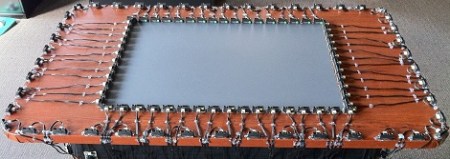
Finally [Michelle Annett] can talk about her super secret project she did at Autodesk Research.
Medusa, as [Michelle]’s project is called, is a Microsoft Surface that has been fitted with 138 proximity sensors. This allows the Surface to sense users walking up to it, and detect users hands and arms above the table top. Multiple users can be detected at the same time, and the left and right hands of two users can be mapped to specific users.
The proximity sensors [Michelle] used are inexpensive, so we’re wondering when someone with a crazy multitouch setup will add proximity sensors to their build. We’d like to play with Medusa, even if just for a virtual game of Settlers of Catan. It seems like the perfect setup…
[Michelle] built Medusa last January during her internship at Autodesk. Now that UIST 2011 is over, she can finally talk about it. There’s also a video demonstrating the possibilities of Medusa, check it out after the break.
Thanks [Fraser] for sending this one in.
[youtube=http://www.youtube.com/watch?&v=rjbKmyxCuEw&w=470]















neat
I think that video stripped a gear in my mind.
When they add a Z-axis to that thing there will actually be a use for 3D.
http://mkannett.blogspot.com/2011/10/medusa.html blank page.
looks like someone is trying to snuff out your project.
try using tor to host your page
Great results and a new way to approach the problem
to be critical:
I’m surprised a company would do something like this. Please post the BOM if this is the inexpensive route. These sensors are cheap (around 10 usd), but 138 of them? and are those ADCs on each sensor? These look like the Sharp IR proximity sensors that Sharp has discontinued (recently recontinued?)
I would just like to clarify that this is a research prototype, and not a product. Quite often, the point of a prototype in a research capacity is to show what could be possible in the future (in this case, a future where proximity sensors are produced for pennies). You are correct, they are sharp distance sensors, and when buying them off the shelf, they do cost $10.
Well, and if that’s the MS surface device I know of, those things are upwards of 10k. So the cost of the prox sensors relative to the core device is probably is pretty good, considering the added utility you got.
The ultimate Ouija board for a psychic party! Put the scare into your friends!!!
If steve jobs wouldnt of passed imagine what he would have created. The iSense seems rather marketable.
you mean stole from other hard working independent developers before they could get a patent?
probably lots of amazing stuff!
more or less…. but that is how everything is created.
Innovate/ripoff/repeat
you think AutoDesk the cappen’ of sleek could do a better job at making it look nice XD
from the video it looks like it barely works and lags like crap
I’m sure the proximity aware multi-touch prototype that you built works so much better… Oh wait.
Nice work [Michelle].
She did this during her internship dude, it’s a prototype and a very well functioning one at that.
I could write something like “show us what 100% working prototypes you did during your internship”, but i’ll leave it at the first paragraph.
(yes, a bit late)
Because you know Steve Jobs, in an immaculate materialization, shat out a perfectly working and beautifully functional iPhone after a particularly spicy dinner of vegetarian vindaloo. Investors and fanbois alike were amazed, no prototypes needed.
Great prototype. Good work. Proximity sensors always seem to pop up in my techie musings.
I’ve seen a lot of cool things come from Autodesk’s labs. It just surprising with the apparent quality of people that they have that AutoCAD still has bugs that have been around since R14.
I patent using this method to detect dong actions.
Inexpensive? That table is encrusted in $20-a-pop Sharp IR sensors.
If you really want to do that inexpensively, put a Kinect over the table and an infrared camera under the table. You could even keep the IR distance sensors and just drop the density by an order of magnitude.
they should use rfid for quick user login
I wonder if you can combined some of this with the open source Kinect. As this guy: http://www.youtube.com/user/okreylos